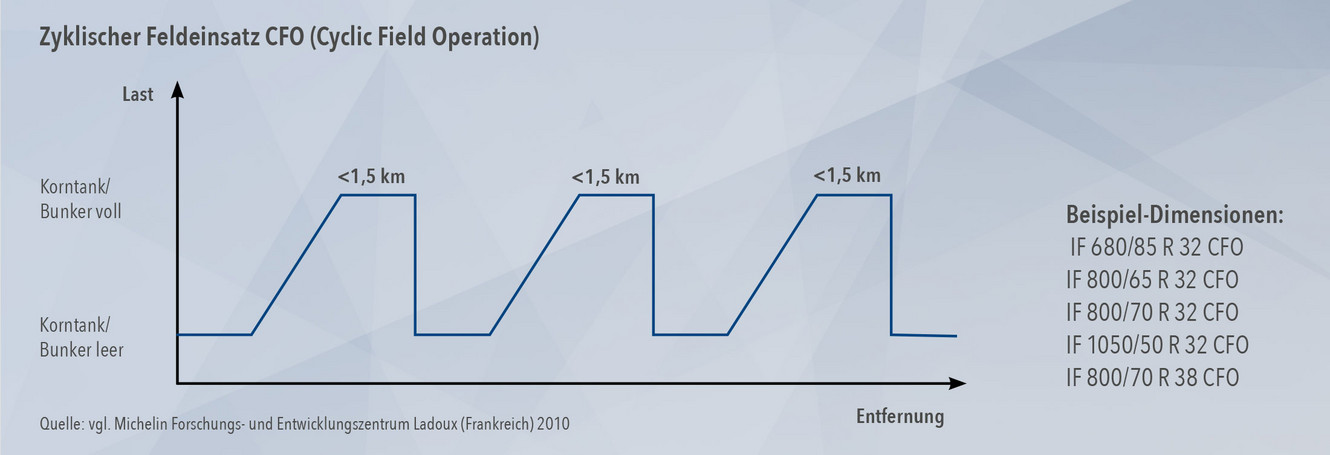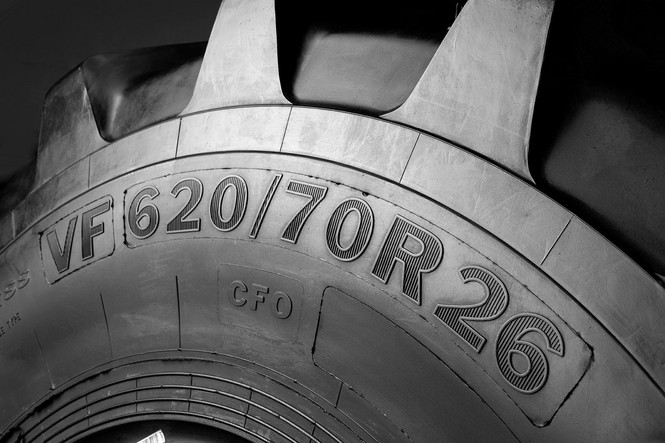Cyclical field and harvesting operations are characterised by recurring loading and unloading intervals, which mainly occur during harvesting: a machine drives onto the field with an empty loading wagon or bunker. During the harvesting run, the increasing quantity of harvested crop adds to the machine weight and thus the load on the tyres linearly, until the bunker or loading trolley has reached its capacity limit and must be unloaded.
The unloading process causes the load on the tyres to drop immediately; the cycle begins again.
Here are the most important abbreviations you should know.
CHO(Cyclic Harvesting Operation) and
CFO(Cyclic Field Operation)
These tyres with CHO and CFO markings are specially designed for agricultural machines that have to carry and transport higher loads over short field transport cycles (up to max. 1.5 kilometres). The abbreviations stand for cyclic harvesting operation (CHO) or cyclic field operation (CFO).
Essentially, CHO and CFO refer to the same tyre characteristics – only the CHO designation has become established for standard tyres in accordance with ETRTO S. A20 for harvesting machines that are subject to cyclic loads, while the CFO marking is used for tyres with IF or VF technology in accordance with ETRTO S. A27.
Under normal conditions over short distances in the field at a speed between 10 and a maximum of 15 km/h, both tyre types can carry a significantly higher load than the specified load capacity. The permitted field driving distance with such an overload is generally up to a maximum of 1.5 kilometres. Precise information on this permissible intensive use can be found in the technical data sheets of any tyre with a CHO or CFO marking.
HLV (High Load Variation) and LLV (Low Load Variation)
The abbreviations HLV and LLV on a tyre, on the other hand, refer to the type of load change that the tyre of a towed vehicle must withstand during its application.
HLV (High Load Variation): This type of tyre can withstand large load fluctuations by a factor of 2 between unloaded and loaded conditions. This type of load change occurs, for example, with loading and transfer vehicles. However, precise monitoring of the tyre pressure is required to ensure the safety and performance of the tyre under these conditions. In addition, tyre manufacturers often recommend distance and speed limits for such scenarios. More details can be found in the tyre's respective air pressure tables.
LLV (Low Load Variation): These tyres are suitable for scenarios with a constant load, such as transport services or tractors in the field, where the tyre load fluctuates significantly less, for example with tillage and forage harvesting machines
NRO (Narrow Rim Option)
NRO tyres bring old rims and new tyre technology together. NRO-labelled treads are almost always modern IF/VF tyres. These highly flexible tyres are typically combined with wider rims.
However, tyres with the abbreviation NRO for "Narrow Rim Option" can not only be mounted on a wide rim – they also deliver their full performance on the previous standard rim. This benefits farmers who want to switch to IF or VF tyres but also avoid the costly purchase of new rims. NRO tyres offer flexibility in tyre choice and allow farmers to use their existing rims without having to forego the advantages of modern, soil-friendly tyres.





